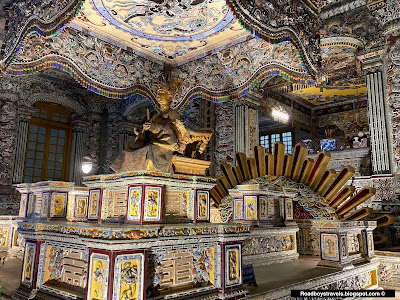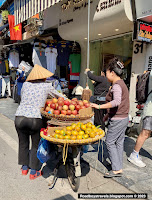Vietnam's Contrary Capital
My Vietnam Backstory
My life has been blessed. I have never had to shoulder a weapon in war, endure hunger or worry about having a roof over my head. Overall my health has remained good for most of my 67 years and I have healthy children and grandchildren.
I was able to follow the American sequence for success. I became the first one in my family to attend and graduate from a University. It was at a time when higher education was still comparatively affordable. I worked hard and graduated debt free. And, the knowledge gained from college, allowed me to eventually found my own practice.
But the one anomoly in my teen years was Vietnam. I never understood the Vietnam "conflict". My childhood in Oakland was framed by antiwar riots in Berkeley, SF State, and at Oakland's Clay Street Induction Center.
I lived with very conservative parents. To them the psycho Joe McCarthy was a hero. They completely believed "commies" had infiltrated every level of the US government. In their eyes if communism was left unchecked anywhere, it would inevitably lead to soviet style domination everywhere.
Kennedy and Johnson were perceived by them as lying liberals. But, when America's truly epic liar, Richard Nixon, became president they believed anything he said. As soon as I was able to vote I took great pleasure in using my vote to cancel out one of theirs.
I earned spending money during high school by working nights, weekends, and summers at the City owned parking lots in downtown and Jack London Square. The Clay Street garage I worked in was directly across the street from Oakland's Induction Center where all Vietnam draftees reported. Upon entering this building all youthful innocence was surrendered forever.
All day, every day, when I worked in my little parking lot booth at Clay Street I watched the endless lines of nervous young men being consumed by the Vietnam "conflict".
My resentment about eventually having to join that line, and possibly surrender my life for something three consecutive presidents and the US Congress never had the guts to call a war, slowly began to overwhelm me. I knew I had a future and I did not want to offer it up for something I could not understand and certainly did not believe in.
Now, don't get me wrong, I love my country. If an enemy were to attack our shores I'd willingly surrender my life and fight with my bare hands.
Protesting The Vietnam War From the Clay Street Garage
Photo: Oakland Local Wiki
All this led to one of the very few times in my life when I risked an open conflict with my father. I told him that, until someone could give me a damn good reason I could fully understand, I was unwilling to go to Vietnam and would seek asylum in Canada before surrendering to the draft. Dad muttered how much it hurt knowing his only son "had a yellow streak running down his back" and walked away from me. It was one of the most painful moments in my life.
Years later, dad quietly told me he had come to the conclusion I'd been right about "that Vietnam thing".
So to this day, the word Vietnam evokes an unresolved part of me. And, like most things in my life, confronting the unresolved is the only way I know to overcome it.
So my trip to Vietnam would involve far more than sightseeing.
Hanoi
The history of Vietnamese Hanoi began in 1010 when Ly Thaí Tô established it as a strategic stronghold naming it "Soaring Dragon".
When the Nguyen dynasty was established in 1802 Vietnam's capital was moved to Hué.
In 1873 the French arrived and in 1887 the French military decreed Hanoi as the capital of "French Indochina".
The Japanese invaded and occupied Hanoi during WWII.
After WWII control returned to the French colonists until their defeat at Dien Bien Phu in 1954. The country was left divided during the Geneva Conference.
Elections were scheduled to reform the country under a unified government. The communists in the North, supported by the farmers in the south, were favored to win the elections. But when the leader of South Vietnam Ngo Dinh Diem refused to hold elections, the US government threw its support behind him. This left the capital of a Communist regime in North Vietnam while Saigon became the capital of South Vietnam.
The Communist North, under Ho Chi Minh, commenced a guerilla war to recapture the South. American politicians quickly decreed that letting Vietnam fall to communism would enable the spread of communism throughout Asia. Of course, they never offered proof of those claims.
In 1964, LBJ capitalizing on a reported attack on US ships, proffered the Gulf of Tonkin resolution. It formed the excuse to escalate the Vietnam "Conflict". The US propped up and toppled successive (hopelessly corrupt) South Vietnamese regimes until our final defeat in 1976. At that time Vietnam was reunified with Hanoi becoming the capitol of the entire nation.
Now, almost fifty years later, Vietnam operates under the iron rule of the communist party. The party first attempted to create a centrally controlled economy. It failed and then unleashed the sleeping tiger of free enterprise. Today there are highly visible signs of prosperity everywhere. And, although average annual national income still remains painfully low at just $4,000/yr (compared to $6,000/yr in Thailand and $12,000/yr in China respectively), the Vietnamese people I met are happy and optimistic. They anticipate an increasingly brighter future.
Hopefully, Vietnam's path to success will not be cut short by its pervasive culture of political and bureaucratic graft and corruption.
Beep Beep!
A westerner's first shock upon arrival in Hanoi is the traffic. There is no workable mass transit. In this city of over 8,000,000 residents there are swarms of scooters. Scooters are used for hauling unimaginable amounts of materials. We saw scooters with four (or more) riders. Besides cars, the rideshare app Grab offers "hop on the back" scooter services allowing you to quickly book a quick, cheap ride anywhere.
Scooters Scooters Everywhere
Western visitors must take time to understand the rules of the road in Vietnam. It would be suicidal for a westerner to rent a car and attempt to drive in Hanoi traffic. Lane markings are irrelevant. Riding on sidewalks is common. Red lights are mere suggestions.
Yet, after a day, the delicate etiquette of Vietnamese traffic started to make sense.
Everyone honks at each other all the time. But the beep beeps are not "get out of my way" rage honks like in the US. They are more of a "Hey! be aware, I'm here" safety behavior. While riding bikes we became grateful for those thoughtful little beeps that drivers offered as they came upon us and began to pass.
The next thing visitors must learn is how to cross the street. In Vietnam pedestrians simply become little human pebbles disrupting the stream of endless traffic. Once you step off the curb into the swarm of traffic and slowly proceed to cross traffic just flows to either side of you.
Crossing rules are strict and important:
1. First you size up traffic.
2. Slowly step off the curb directly into traffic.
3. Walk forward slowly with purpose.
4. Never step backward or change direction.
5. Never run.
It takes courage to cross swirling Hanoi traffic, but as soon as you become comfortable with how traffic constantly adapts, crossing becomes completely natural.
We arrived a day before our formal tour was to
begin, so we booked our own hotel in Hanoi's old quarter for the first night. It was a lovely
little boutique hotel (Royal Palace 2). I booked a spacious room with a
big balcony overlooking the bustling street scene below. My room rate
(including fast WiFi and a full breakfast) set me back $65 (including
all fees and tax).

First Night Hotel in the Old Quarter
We visited a walk-up Banh Mi stand for very serviceable dinner (which cost about a buck). Even with an eye popping exchange rate of 24,000 Vietnamese Dong to $1, it did not take long to realize that travel in Vietnam is an amazing bargain.
The next morning we slept in and then met up with our Vermont Bike Tours (VBT) group at the swanky nearby Hanoi Melia Hotel in the heart of Hanoi's diplomatic zone.
Our VBT tour began with a detailed walking tour of Ho Chi Minh's mausoleum and residences and our welcome dinner.
The following day was packed. We began with a walking tour, took rides in cyclos (bicycle versions of a rickshaw), toured the Temple of Learning, the infamous Hanoi Hilton, religious sites and finished with an early evening performance of Hanoi's famous water puppets. In between were amazing meals at some very nice restaurants.
Bicycle Street Commerce
A Cyclo Ride Through the Old Quarter
The Hanoi Hilton
Built by the French, the Hanoi Hilton was clearly designed for the purpose of torture and brutal incarceration. Today, most of it has been demolished to make way for new government structures, but the main facade exists along with a series of displays. The displays are now used as a propaganda tool to stress the cruelty of the French (true), but then goes on to stress how "humanely" the Vietnamese treated US fliers (bullshit). John McCain's inability to reach high enough to comb his hair stands as testimony to those lies.
Today everywhere in Vietnam there are smiling images of "Uncle" Ho Chi Minh. The communist party has attempted to elevate him to the status of diety. It is most evident when you visit his huge mausoleum (where, despite his wishes to the contrary, his glass boxed corpse now resides on permanent display like Lenin in Russia). Hearing his story from the Vietnamese perspective did alter my perception of him a bit.
Ho Chi Minh's Mausoleum
After the departure of the French Ho Chi Minh (HCM) refused to live in the elegant presidential palace the French had built. He instead chose to live in a modest home nearby.

Ho Chi Minh's Nearby Residence

Ho Chi Minh's Autos Are Also Preserved
But once you get past all the HCM stuff, the actual City of Hanoi is really a delight. The streets are covered in trees. The French influenced legacy architecture is beautiful, the cultural amenities are rich, and Vietnamese food is wonderful.
But, more than anything, the gracious and friendly people of Hanoi form the real treasure of this City.

Green Canopy Trees Shade Narrow Streets With Picturesque Lanterns in Hanoi's Old Quarter
An Evening with Hanoi's Water Puppets
Hanoi Infrastructure is Reckless
After the heat of Bangkok, the 68° temperatures in for our three days and two nights in Hanoi were very welcome.
Now coming to day three, we faced an early morning flight to our next destination Hué.
Roadboy's Travels © 2023
























































